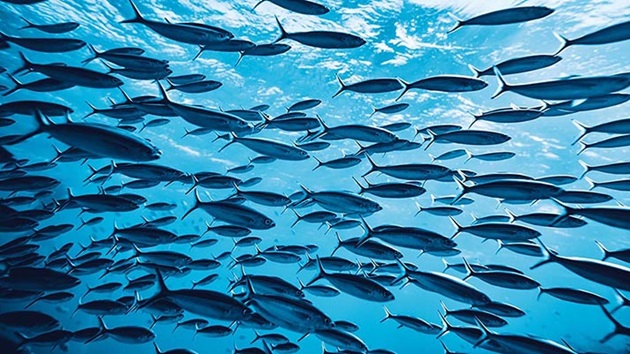People, not science, are the biggest source of uncertainty for the future of sustainable, climate-resilient fisheries.

The 26th Conference of the Parties to the Paris agreement (CoP26) ended little over two weeks ago, promises have been made and the ink is barely dry on commitments to cut global emissions.
Regardless of what those promises will yield, climate change is already wreaking havoc on life on our planet and our oceans. Globally, marine species are shifting distributions, ecosystems’ productivity is changing, corals are bleaching, and unexpected effects are changing relations between predators and prey. In turn, this is causing declining catches, fishing rights conflicts over shifting fish populations (stocks), unpredictable fishing seasons and new interactions with endangered species that fishers do not yet have the tools to address.
A recently published article in Nature Climate Change estimates between 7% and 19% of marine species biomass will be lost in the coming years, depending on how successful we are at cutting emissions. These predictions come from using complex models that link the expected changes in the oceans’ biophysics with their consequences on predators and prey in all levels of the food chain. The picture is bleaker than previously thought.
The paper is just one example of how scientists, often in large collaborative research efforts, have been hard at work trying to understand how biodiversity and fishing resources will be affected by climate change.
As a result, we have greatly improved our ability to diagnose the role of climate change - from predicting where the presence of marine species is expanding or shrinking (e.g., Pinsky et al., 2013) and declines in fisheries productivity (Free et al., 2020), to changes in wildlife interactions from the poles to the tropics (Babcock et al 2019; Huntington et al 2020; Cavanagh et al 2021; Throne & Nye, 2021).
Shifting stocks
But one thing CoP 26 has clearly shown is that, even with increasingly compelling and accurate evidence (as in the latest IPCC report), getting people to agree on vital decisions is harder than one might think.
Take, for example, the case of fished populations moving into new jurisdictions. Managing transboundary stocks is already known to be extremely challenging (Pinsky et al 2018; Palacios-Abrantes et al, 2020).
In the North East Atlantic, several fisheries recently lost their MSC certification because management agreements could not keep pace with environmental changes. The proportion of catch that each country is allowed to take from the same shared stock, or quota, was first negotiated in the late 1970s. Since then, fish have moved into new areas to adapt to warming waters. While some states are harvesting new resources that have expanded in their waters, others are not reducing their quotas accordingly.
This failure to respond to the new circumstances in a coordinated way means the total catch of populations of mackerel, Atlanto-scandian herring, and blue whiting -- important prey in the foodweb as well as economically valuable resources - exceeded the recommended threshold. The solution to keep fishing pressure sustainable is for all parties to agree a new, multi-national quota allocation system. But that journey is still unfolding.
This is not the only case where people are trying to keep up with moving fish. New adaptive ways of assigning quotas that dynamically change as the environment changes are being tested, for example within a project I am involved in - funded by the Lenfest Ocean Program - exploring different strategies for fishing quota allocation on the U.S. East coast. The recent decision by the Mid Atlantic Fisheries Management Council (MAFMC) to adjust black seabass state quotas to account for shifting distributions is a clear sign that stakeholders are open to considering new avenues.
Working with unknowns
None of this means that scientists have worked out all there is to know about climate change impacts. There are still many unknowns. In fact, we may never reach a point where we can fully anticipate ecological changes.
Adapting fisheries management to a changing environment will likely rely increasingly upon the continuous monitoring of data (as recommended by Collie et al., 2021) to capture unexpected changes in how much fishing can be sustained, or new impacts on wildlife that require management intervention as they happen (Carruthers & Hordyk, 2019; Kadin et al, 2019). When management capacity can’t afford sufficiently frequent monitoring, more precautionary methods will be needed to buffer against uncertainties (Goethel et al 2019).
In fact, data collection and the application of the precautionary approach are already well-established best practice principles for governing fisheries (Free et al 2020). Science-based fisheries management relies on ‘harvest strategies’: these lay out exactly how and by how much to reduce fishing if a certain sustainability threshold is crossed. This approach means action can be taken quickly, since the response is pre-agreed in a well-known plan.
The consequences of delayed action
But what happens when climate change presents new problems that fishery managers had not planned for? In these cases the data may be (reasonably) clear about the problem, but intervention can be slow if institutions need to come up with novel solutions and reach consensus across all interested parties before they can act.
The tragic deaths of critically endangered North Atlantic right whales in the Gulf of St Lawrence, provides a tangible measure of the impact of delayed action. Seeking their preferred food in response to changes in their environment, right whales came into unprecedented contact with crab pots. The pots are connected to the surface by long ropes that some whales become entangled in causing them to drown.
For the MSC certified snow crab fishery in the Gulf of St Lawrence, this meant suspension from the program. Managers reacted when the problem became apparent but missed early signals. They now use adaptive closed areas when whales are sighted, improved gear markings, and daily overflights. They’re also working with fishers on gear modifications to prevent similar incidents in the future.
Greater collaboration and quicker decisions are essential
Climate change resilience and adaptation will be especially vital for lower income and small-scale producers who are likely to be the most heavily impacted (Tigchelaar et al 2021). While the same principles of management best practice apply in these contexts, any progress towards improved fisheries sustainability will not serve to improve livelihoods and food provision without addressing policy ‘blind spots’ on fair distribution, access to resources, and gender representation (Farmery et al 2021)
Climate change exposes the fragilities in our decision-making processes, putting to the test international cooperation, the ability to consult and consider the needs of all relevant stakeholders and to build resilience, especially where adaptation to alternative livelihoods is difficult.
Some of the existing principles of sustainable fisheries management, particularly around robust harvest strategies and multi-stakeholder cooperation, are likely to become even more relevant in this future. Where they are not enough, we will need more information and new solutions.
But, while there are still many unknowns, we cannot wait for greater certainty to take action. To guarantee the future of our oceans’ ecosystems, as well as of the people relying on them, we need institutions and stakeholders to roll up their sleeves and work together - now.



